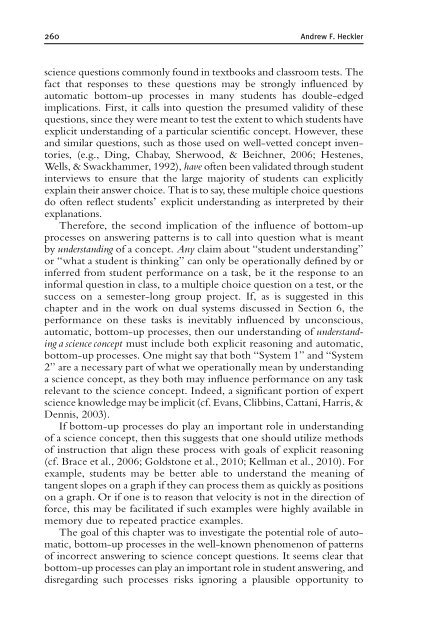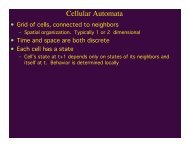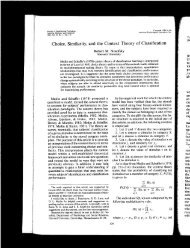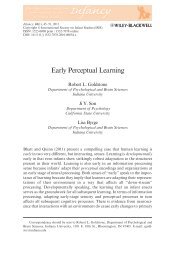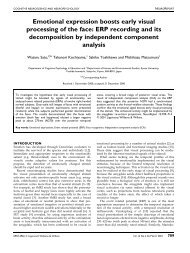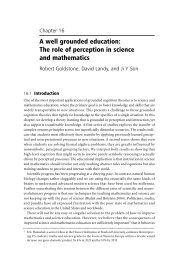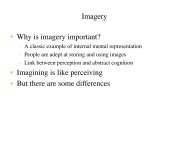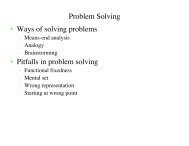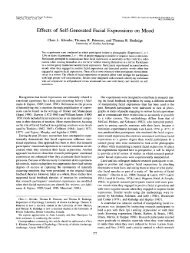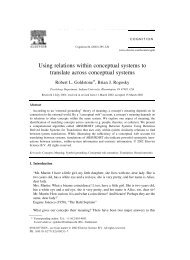the psychology of learning and motivation - Percepts and Concepts ...
the psychology of learning and motivation - Percepts and Concepts ...
the psychology of learning and motivation - Percepts and Concepts ...
You also want an ePaper? Increase the reach of your titles
YUMPU automatically turns print PDFs into web optimized ePapers that Google loves.
260 Andrew F. Hecklerscience questions commonly found in textbooks <strong>and</strong> classroom tests. Thefact that responses to <strong>the</strong>se questions may be strongly influenced byautomatic bottom-up processes in many students has double-edgedimplications. First, it calls into question <strong>the</strong> presumed validity <strong>of</strong> <strong>the</strong>sequestions, since <strong>the</strong>y were meant to test <strong>the</strong> extent to which students haveexplicit underst<strong>and</strong>ing <strong>of</strong> a particular scientific concept. However, <strong>the</strong>se<strong>and</strong> similar questions, such as those used on well-vetted concept inventories,(e.g., Ding, Chabay, Sherwood, & Beichner, 2006; Hestenes,Wells, & Swackhammer, 1992), have <strong>of</strong>ten been validated through studentinterviews to ensure that <strong>the</strong> large majority <strong>of</strong> students can explicitlyexplain <strong>the</strong>ir answer choice. That is to say, <strong>the</strong>se multiple choice questionsdo <strong>of</strong>ten reflect students’ explicit underst<strong>and</strong>ing as interpreted by <strong>the</strong>irexplanations.Therefore, <strong>the</strong> second implication <strong>of</strong> <strong>the</strong> influence <strong>of</strong> bottom-upprocesses on answering patterns is to call into question what is meantby underst<strong>and</strong>ing <strong>of</strong> a concept. Any claim about ‘‘student underst<strong>and</strong>ing’’or ‘‘what a student is thinking’’ can only be operationally defined by orinferred from student performance on a task, be it <strong>the</strong> response to aninformal question in class, to a multiple choice question on a test, or <strong>the</strong>success on a semester-long group project. If, as is suggested in thischapter <strong>and</strong> in <strong>the</strong> work on dual systems discussed in Section 6, <strong>the</strong>performance on <strong>the</strong>se tasks is inevitably influenced by unconscious,automatic, bottom-up processes, <strong>the</strong>n our underst<strong>and</strong>ing <strong>of</strong> underst<strong>and</strong>inga science concept must include both explicit reasoning <strong>and</strong> automatic,bottom-up processes. One might say that both ‘‘System 1’’ <strong>and</strong> ‘‘System2’’ are a necessary part <strong>of</strong> what we operationally mean by underst<strong>and</strong>inga science concept, as <strong>the</strong>y both may influence performance on any taskrelevant to <strong>the</strong> science concept. Indeed, a significant portion <strong>of</strong> expertscience knowledge may be implicit (cf. Evans, Clibbins, Cattani, Harris, &Dennis, 2003).If bottom-up processes do play an important role in underst<strong>and</strong>ing<strong>of</strong> a science concept, <strong>the</strong>n this suggests that one should utilize methods<strong>of</strong> instruction that align <strong>the</strong>se process with goals <strong>of</strong> explicit reasoning(cf. Brace et al., 2006; Goldstone et al., 2010; Kellman et al., 2010). Forexample, students may be better able to underst<strong>and</strong> <strong>the</strong> meaning <strong>of</strong>tangent slopes on a graph if <strong>the</strong>y can process <strong>the</strong>m as quickly as positionson a graph. Or if one is to reason that velocity is not in <strong>the</strong> direction <strong>of</strong>force, this may be facilitated if such examples were highly available inmemory due to repeated practice examples.The goal <strong>of</strong> this chapter was to investigate <strong>the</strong> potential role <strong>of</strong> automatic,bottom-up processes in <strong>the</strong> well-known phenomenon <strong>of</strong> patterns<strong>of</strong> incorrect answering to science concept questions. It seems clear thatbottom-up processes can play an important role in student answering, <strong>and</strong>disregarding such processes risks ignoring a plausible opportunity to


